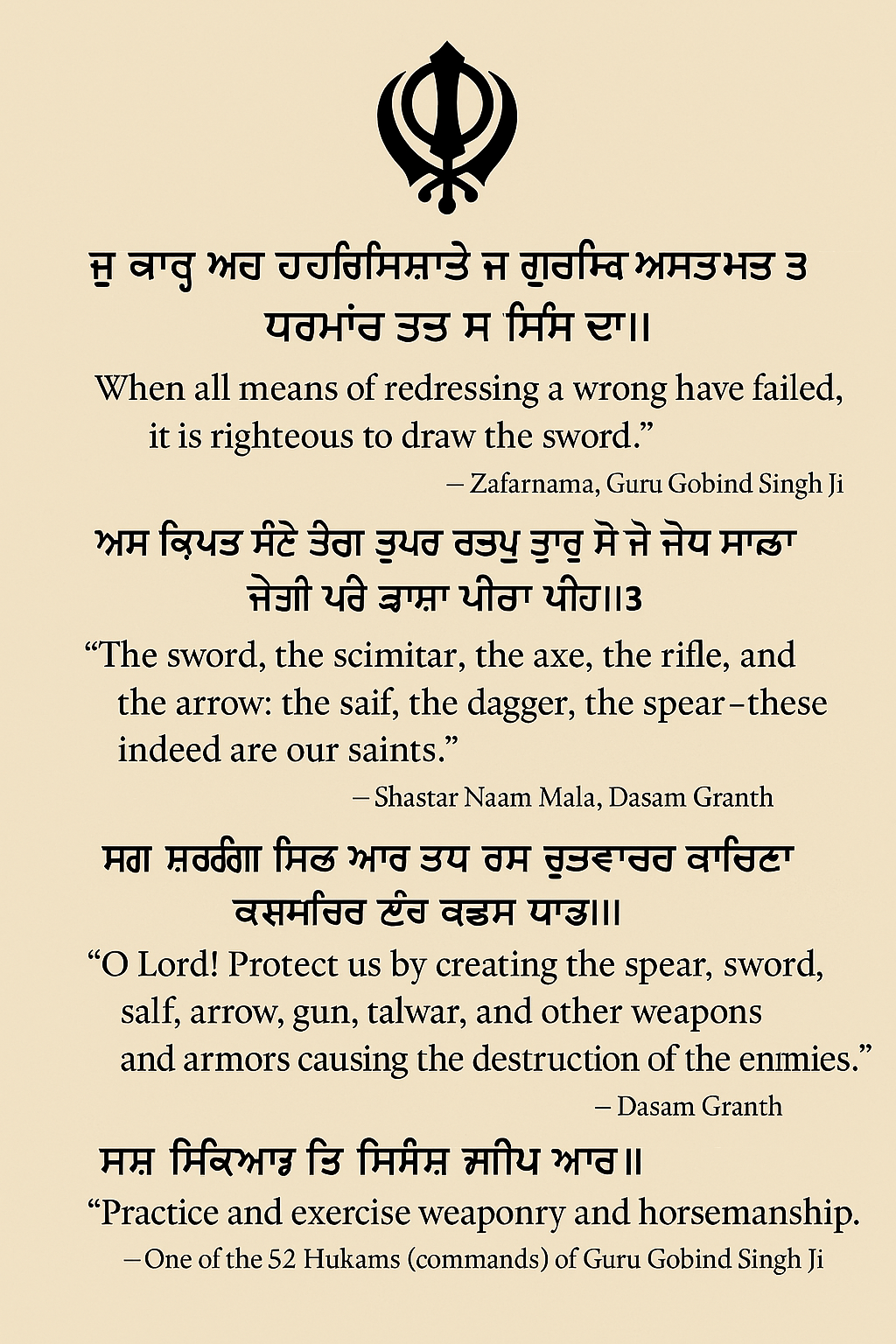ਤਿਆਰ ਬਰ ਤਿਆਰ - Tyar Bay Tyar
In the modern era, the Sikh principle of being "Tyar Bar Tyar" (Ready at all times) remains as relevant as ever. Here's why weapons training continues to be an essential part of the Sikh way of life:
- Religious Duty: Guru Gobind Singh Ji instructed Sikhs to be both Sant (Saints) and Sipahi (Warriors). This dual responsibility continues in the modern world.
- Self-Defense: In an increasingly uncertain world, the ability to protect oneself and others is crucial. This aligns with the Sikh principle of standing up against injustice.
- Community Protection: Sikhs have historically been defenders of the oppressed. Modern weapons training enables us to continue this sacred duty.
- Cultural Preservation: Maintaining proficiency in weapons connects us to our martial heritage and the discipline of Shastar Vidya.
- Mental Discipline: Weapons training develops focus, discipline, and mindfulness - qualities essential for both spiritual and worldly success.
- Physical Fitness: Regular training maintains the body as a temple, following the Sikh principle of keeping the body strong and capable.
- Responsibility: Learning proper weapons handling teaches responsibility, safety, and respect for tools of defense.
Gurbani
Sri Guru Granth Sahib Ji emphasizes the warrior spirit, with numerous references to weapons (shastar) as divine tools for protecting righteousness. Guru Gobind Singh Ji further elevated this principle, declaring "Shastar Naam Mala" - recognizing weapons as sacred extensions of divine will when used in defense of dharma.
In Dasam Granth, Guru Gobind Singh Ji explicitly states that weapons must be respected and maintained with the same devotion as prayer. The text emphasizes that a Sikh's martial capabilities are inseparable from their spiritual development - two edges of the same sword.
Guru Gobind Singh Ji's Hukam
"ਸ਼ਸਤ੍ਰ ਹੀਣ ਕਬਹੂ ਨਹਿ ਹੋਈ, ਰਿਖੀ ਰਾਜ ਸਦਾਈਯੈ ਸੋਈ"
"One cannot be a ruler without weapons, only they who are armed can be called kings"
Guru Gobind Singh Ji commands that a Sikh must never be without arms. This command, or Hukam, makes clear that being armed and trained is not optional - it is a fundamental duty of the Khalsa.
The Zafarnama further reinforces this, with Guru Gobind Singh Ji explaining that taking up arms becomes not just permissible but necessary when all peaceful means have failed. This wisdom has preserved our faith through centuries of persecution.

History of Sikh Armed Survival
The very existence of Sikhs today is a testament to our ancestors' wisdom in maintaining arms and being prepared. During the darkest periods of persecution, it was the armed and trained Khalsa that stood against tyranny. From the sacrifices of Guru Arjan Dev Ji to the battles of Guru Gobind Singh Ji, our history demonstrates why Sikhs must always remain "Tyar Bar Tyar" - prepared and vigilant.
Under Mughal rule, when bounties were placed on Sikh heads and systematic genocide was attempted, it was armed resistance that preserved our faith. The Khalsa's martial preparedness transformed us from victims to warriors, establishing sovereign rule and protecting the innocent of all faiths across Punjab.
During the partition of 1947, when murderous sectarian mobs targeted Sikh communities, it was again our combat readiness that saved countless lives. Armed Sikhs successfully defended their villages and helped evacuate hundreds of thousands of refugees to safety, demonstrating how preparation prevents persecution.
In the 1980s and 1990s, faced with state-sponsored aggression, Sikhs once again proved that an armed and trained community cannot be easily oppressed. Our history repeatedly shows that maintaining arms and training is not about aggression - it's about survival and the protection of dharma.
Even today, Sikhs face persistent threats from multiple directions. Domestic terrorists have targeted our Gurdwaras, as seen in the 2012 Oak Creek massacre. Radical Islamists continue to threaten our communities in Afghanistan, Pakistan, and Europe while certain nation states attempt to suppress our identity and right to self-defense. Sikhs, even those in free countries like the U.S. and Canada, have faced assassination attempts from foreign agencies in recent years. These modern challenges reinforce why Sikhs must maintain our martial traditions and defensive capabilities.

Eternal Vigilance
No one is coming to save us. Time and again, the mouths we feed at langar have come back to bite us; no amount of community-building saved the Sikhs from the horrors of Partition and 1984. Sikhs can only entrust their protection to themselves, as commanded by the Gurus. We cannot rely on acts of heroism from police officers, like the one from the brave Lt. Murphy of Oak Creek, WI. Even then, it was only his weapons training and a firearm with which he was able to stop the massacre in the Gurdwara. Gurdwaras, once considered impenetrable fortresses of God, are now soft targets for killers. This must change.
Today's world demands the same vigilance our ancestors maintained. Whether facing targeted violence or protecting the innocent, Sikhs must maintain the highest level of preparedness. This means regular training, maintaining defensive capabilities, and understanding that our ability to defend ourselves and others is a sacred responsibility passed down through generations.
The peace and stability we experience today is but a temporary illusion. History has shown repeatedly that periods of peace are merely intervals between cycles of violence and persecution. Our ancestors paid for these lessons in blood, and we would be foolish to ignore their wisdom. Evil does not rest permanently - it merely waits for the prepared to become complacent.
Just as our forebears maintained readiness through centuries of relative peace and sudden violence, we too must remain prepared. The comfortable bubble of modern society can burst at any moment, and when it does, it will be those who heeded our ancestors' wisdom who will be able to protect themselves and others.
"ਸੂਰਾ ਸੋ ਪਹਿਚਾਨੀਐ ਜੋ ਲਰੈ ਦੀਨ ਕੇ ਹੇਤ ॥
ਪੁਰਜਾ-ਪੁਰਜਾ ਕਟਿ ਮਰੈ ਕਬਹੂ ਨ ਛਾਡੈ ਖੇਤ ॥"
"He alone is known as a warrior who fights for righteousness.
Even if cut limb by limb, he does not retreat from the battlefield."
- Sri Guru Granth Sahib Ji (Ang 1105)

